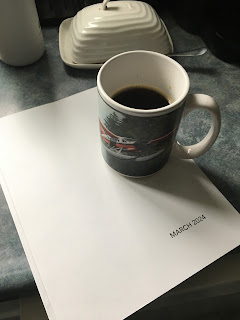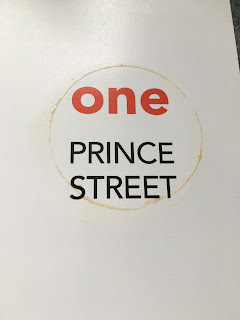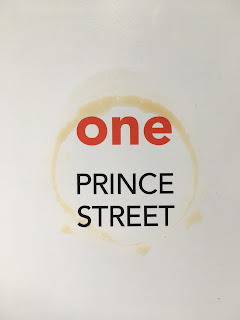In my early elementary educational days at Amherst View Public School (AVPS) we were graced with a somewhat-distant, yet clear view of the CN Kingston Subdivision. The view was best from north-facing classrooms, with the school playground, Amherst Drive and township sports fields between the school and the tracks (between the red lines, with CN double-track mainline running across top of photo - below). We saw a lot of trains, including the very birth of VIA. My
brother suggested that today's students could stay in class and remotely pilot their drones to get a better view!

A few of my classmates and I became our own train-watching club. Compared to today's 'foamers', our resources were scant. There was no internet, not even message boards, and newsletters were filled with stories of what was happening in the big cities. But did that stop us? No. We wrote away to GMDD in London for 8x10 glossy B&W builder's photos. Whether it was TRAINS magazine, Extra 2200 South, or the fledgling Railfan magazine, we learned what we could and noted what we observed.
Drew, Mark and I spent lots of time at the tracks outside school hours, sometimes in Saturday morning pre-dawn darkness whether wind-whistling winter or sticky-humid summer. One day, a dog was struck at the farm crossing near the water tower. All students were told NOT to go up to the crossing after school. I think half the school was there, us included.
I was a late adopter of 35 mm photography among the group. We were all band kids and were able to go on several exchange trips in high school. The
ultimate was a train-plane trip from Kingston to Port Moody, BC in 1980. One of our roles in the ostensibly-educational trip was to prepare a 'boredom prevention package' of maps, puzzles and online information and schedule.
I had the opportunity to reconnect with Drew recently. In town to look after his parents' affairs, we met and in a melancholy moment, I noted that we were both now orphans.
Drew and I made a highlight trip to Hamilton's Bayview Junction in May, 1981 that I still have to profile on Trackside Treasure. With his Konica T4, Drew is retrieving some train orders that were well-travelled (read on!) as Amtrak 344 with 6 cars Amfleet equipment heading south, and fellow foamers. Bayview Jct on June 23, 1981:
And back at ya! Tempo unit CN 3150 passes a [not ours] K-car. We were driving in Drew's parents' Chevy station wagon.
We independently visited CN's Spadina roundhouse in Toronto in the era that a descent from the Spadina Street overpass (or visit with Steampipe who lived along the tracks) and a signature on a release form was all that was required. Then cab visits via monkey-bar MLW-climbing, jungle-gym Geep data-gathering, and cab-unit clambering ensued.
Getting together over grain-based beverages, we were able to wallow in nostalgia and share punchlines, memories and stories that no-one else would know, at least outside our own small group from 40 years ago. Some days, I can't remember by noon what I had for breakfast, but these long-gone details were close to the frontal lobes of our memory.
We chatted for hours, mere steps from the Hanley Spur joint track section that ended at lower Princess Street (present-day and archival views - above). If I cocked my ear, I thought I could hear flange squeal and the escaping steam down the alley - CN and switchers dragging out just-built CLC's and CP mixed trains going back and forth. We even discussed our limited Hanley Spur memories - Mark's Grampa Miller at Knapp's Boat Works and the HMCS Inch Arran that Drew used to call 'the battleship'! (Plus, there was Grampa Chet and Gramps Reynolds - so many grampas!)
We got to adulting issues like aging parents, estate management, former teachers, family and friends, and retirement options among the SD40's, RDC's and VIA trains trips along the pathways from our pasts. Drew was a member of my wedding party, and we both had roles in Mark's wedding. Mark is still a pilot. Speaking of flying, living out West, Drew has to fly home periodically. We caught up on all our former classmates, relishing several instances of RFTD (Return From The Dead). That's our term for fellow students who we'd thought had disappeared, then magically pop back into our lives in unexpected ways.
Drew has occasionally and generously gifted me with some of his railfan heirlooms from his parents' place, including the notable train orders from Bayview above. And this visit was no different.
At 1324 on November 4, 1978 I Instamatically photographed CN 4518 with a couple of CN hoppers in tow ahead of caboose 79449, passing the Amherst View water tank with railfan friend Drew sitting on the fence getting a much better view. The view has changed, trees felled, new trees grown, fencing added, visibility subtracted, but the memories of trains we watched here remain.
They say old friends are the best friends, and I think that's true.
Running extra...
 I'm so proud to share in fellow blogger Chris Mears' success elation at the publication of his first magazine ONE. To quote Chris, "Making One was not a copy-paste job. The magazine is filled with new drawings, new words. I loved making this art so much and that alone powered me through so many moments where I wanted to 'not do this anymore'....Prince Street has existed for fifteen years and feels, at times, like it has its own character. That said, holding onto One is exactly what I wanted it to feel like: offline, released from under glass. There is nothing like the feel of paper. I love it."
I'm so proud to share in fellow blogger Chris Mears' success elation at the publication of his first magazine ONE. To quote Chris, "Making One was not a copy-paste job. The magazine is filled with new drawings, new words. I loved making this art so much and that alone powered me through so many moments where I wanted to 'not do this anymore'....Prince Street has existed for fifteen years and feels, at times, like it has its own character. That said, holding onto One is exactly what I wanted it to feel like: offline, released from under glass. There is nothing like the feel of paper. I love it."
Chris was kind enough to let me know my copy is already on its way. I believe strongly in encouraging and supporting each other as we rubber ball-bounce around the boundless blogosphere. It's great to see Chris busting out of the blogosphere into new media like video and publishing. That moment he experienced took me back to seeing the first draft of my VIA Rail book on a work computer, sent to me by my graphic designer Bryan Babcock. It's a given that Chris has put a lot of thought into everything he does. It's so nice to see something than the usual rota of MR press articles: Concept, Benchwork, Wiring, blah-blah-blah-boring. I heartily hope you'll check out Chris' work.
I know that Chris values having things to look at in our hands. He's announced that the first print run has already sold out! So I can't wait to get my hands on his magazine and I'm looking very much forward to TWENTY-SEVEN. No pressure, Chris!











































.jpg)










.jpeg)





.jpeg)










